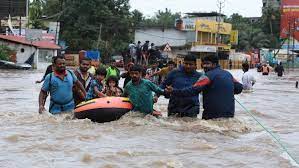06 Aug 2022 Floods in kerala

- Kerala is once again facing a flood-like situation, as witnessed in the year 2018 with high intensity rainfall due to strong monsoon winds.
- Apart from this, a low pressure area is expected to form over Bay of Bengal within 2-3 days, which is likely to increase rainfall.
Floods in Kerala in the year 2018:
- The worst floods in Kerala since 1924 came after torrential rains in August 2018.
- The gates of the dam had to be opened due to water filling up to the banks of the dams and a lot of water accumulating at other places as well.
- At least 35 of the 50 major dams had already been opened to release water to the flooded areas.
- Over time, siltation had significantly reduced the water holding capacity of the dams and surrounding rivers, leading to flood waters in embankments and streams.
- Sedimentation which reduced the built-up area of the dam (reducing its holding capacity), sand mining and large-scale felling of trees and forest clearance in the Western Ghats also played a major factor in the floods.
Flooding:
- It is generally an overflow of water on dry land. Floods can occur due to heavy rains, the presence of large amounts of water along the coast, rapid melting of ice and breaking of dams, etc.
- Flooding i.e. only a few inches of water flow or water reaching the roofs of houses can have harmful effects.
- Floods can occur over a short period of time or over a long period of time and can last for days, weeks or more. Floods are the most common and widespread of all weather-related natural disasters.
- Flash flood is the most dangerous type of flood, as it can give a devastating form to flood.
Major causes of continuous flooding in urban areas:
Unplanned Development:
- Unplanned development, encroachment in coastal areas, failure of flood control structures, unplanned reservoir operations, poor drainage infrastructure, deforestation, change in land use and sedimentation in river bed lead to flood events.
- During heavy rains the river breaches embankments and damages the communities living along the banks and sand belts.
Unplanned Urbanization:
- Floods have become a common occurrence in cities and towns.
- This is due to indiscriminate encroachment of waterways and wetlands, inadequate capacity of drains and lack of maintenance of drainage infrastructure.
- Poor waste management reduces the water-carrying capacity of drains, canals and lakes.
Neglect of pre-disaster planning:
- The history of flood management shows that the focus of disaster management has been mainly on post-flood compensation and relief.
- Many reservoirs and hydro-electric plants do not have adequate gauging stations to measure flood levels, which are a key component of flood forecasting.
Ignoring the recommendations of the Gadgil Committee:
- In the year 2011, the Madhav Gadgil Committee recommended the declaration of an area of about 1,30,000 sq km as an eco-sensitive zone (extended to Gujarat, Karnataka, Kerala, Maharashtra and Tamil Nadu).
- Although none of the six states agreed with Kerala’s recommendations, these states specifically objected to the proposed ban on mining, ban on construction activities and ban on hydroelectric projects.
- The result of this negligence is now clearly visible in the form of frequent floods and landslides.
yojna IAS daily current affairs 6th August


No Comments